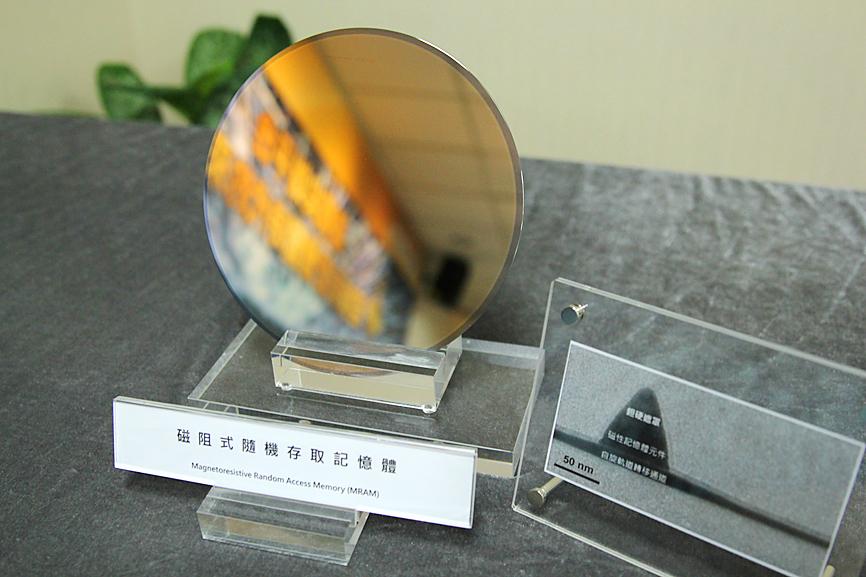The Taiwan Semiconductor Research Institute (TSRI) yesterday unveiled a new memory device it developed with university researchers, saying that they are the world’s second team after Intel to make the breakthrough.
Magnetoresistive random access memory (MRAM) is widely regarded as having the potential to become a mainstream device, TSRI Fabrication Service Division director Li Kai-shin (李愷信) told a news conference in Taipei.
To develop the device, global manufacturers have been working on various techniques, including spin-transfer-torque MRAM (STT-MRAM) and spin-orbit-torque MRAM (SOT-MRAM), although SOT-MRAM is still mostly in the research phase, he said.

Photo courtesy of the National Applied Research Laboratories
The institute has worked with local researchers to develop a SOT-MRAM device that can read data faster, while consuming less energy and undergoing any number of operations, than an STT-MRAM device, he said.
Their key breakthrough came by using a challenging technique called perpendicular magnetic anisotropy (PMA) to turn the magnetic poles vertically within the device, enabling them to develop a memory device that is smaller, he said.
After Intel, they are only the world’s second team to have achieved the breakthrough, Li said, adding that they published their findings in a paper for the Symposium on VLSI Technology and Circuits in June.
The manufacturing process involves the structuring of more than 30 layers of film, each of which only measures 0.4 nanometers, he said.
While Intel did not reveal the structural features of its device, the team clarified the physical mechanism involved in making the device, he added.
Other team members include National Tsing Hua University materials science and engineering professor Lai Chih-huang (賴志煌), National Taiwan University electrical engineering professor Liu Chee-wee (劉致為) and researchers at the Industrial Technology Research Institute (工業技術研究院).
The institute’s key equipment for developing MRAM include a physical vapor deposition system purchased from US firm Applied Materials and an etching system purchased from Japan, Li said.
Compared with semiconductor firms, the institute’s facilities might not contain the most state-of-the-art equipment, but students have learned through trial and error, and are prepared to work in the chip industry, Liu said.
The team’s breakthrough is significant, but it is difficult to say when the SOT-MRAM device might enter mass production, TSRI Deputy Director-General Shieh Jia-min (謝嘉民) said.
Asked whether the technique would be transferred to domestic manufacturers, Shieh said that it takes time for technology transfers, although the team hopes to engage with more local equipment and materials suppliers.
Based at the Hsinchu Science Park (新竹科學園區) with facilities in Tainan, TSRI is one of the eight laboratories under the National Applied Research Laboratories (NARL).
British Representative to Taiwan John Dennis met with NARL President Wu Kuang-chong (吳光鐘) to discuss semiconductor research and development in Taiwan, expressing the hope that the UK and Taiwan could expand their cooperation in tech-related industries, the British Office Taipei wrote on Facebook on Thursday.

US climber Alex Honnold is to attempt to scale Taipei 101 without a rope and harness in a live Netflix special on Jan. 24, the streaming platform announced on Wednesday. Accounting for the time difference, the two-hour broadcast of Honnold’s climb, called Skyscraper Live, is to air on Jan. 23 in the US, Netflix said in a statement. Honnold, 40, was the first person ever to free solo climb the 900m El Capitan rock formation in Yosemite National Park — a feat that was recorded and later made into the 2018 documentary film Free Solo. Netflix previewed Skyscraper Live in October, after videos

Starting on Jan. 1, YouBike riders must have insurance to use the service, and a six-month trial of NT$5 coupons under certain conditions would be implemented to balance bike shortages, a joint statement from transportation departments across Taipei, New Taipei City and Taoyuan announced yesterday. The rental bike system operator said that coupons would be offered to riders to rent bikes from full stations, for riders who take out an electric-assisted bike from a full station, and for riders who return a bike to an empty station. All riders with YouBike accounts are automatically eligible for the program, and each membership account

NUMBERS IMBALANCE: More than 4 million Taiwanese have visited China this year, while only about half a million Chinese have visited here Beijing has yet to respond to Taiwan’s requests for negotiation over matters related to the recovery of cross-strait tourism, the Tourism Administration said yesterday. Taiwan’s tourism authority issued the statement after Chinese-language daily the China Times reported yesterday that the government’s policy of banning group tours to China does not stop Taiwanese from visiting the country. As of October, more than 4.2 million had traveled to China this year, exceeding last year. Beijing estimated the number of Taiwanese tourists in China could reach 4.5 million this year. By contrast, only 500,000 Chinese tourists are expected in Taiwan, the report said. The report

Temperatures are forecast to drop steadily as a continental cold air mass moves across Taiwan, with some areas also likely to see heavy rainfall, the Central Weather Administration (CWA) said. From today through early tomorrow, a cold air mass would keep temperatures low across central and northern Taiwan, and the eastern half of Taiwan proper, with isolated brief showers forecast along Keelung’s north coast, Taipei and New Taipei City’s mountainous areas and eastern Taiwan, it said. Lows of 11°C to 15°C are forecast in central and northern Taiwan, Yilan County, and the outlying Kinmen and Lienchiang (Matsu) counties, and 14°C to 17°C